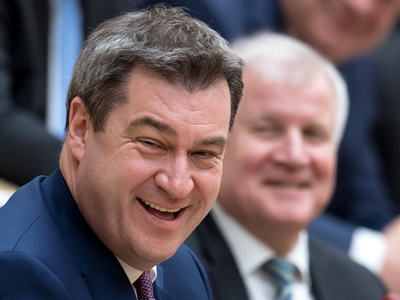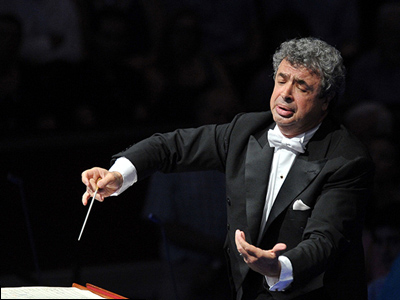
By ANDREW POWELL
Published: March 21, 2018
MUNICH — Bavaria’s Culture Ministry, responsible for Bayerische Staatsoper and Staatstheater am Gärtnerplatz, among many other entities, underwent a sudden double shake-up this morning with the firing of its cheerful chief, Ludwig Spaenle, and an organizational severing into two parts.
Bernd Sibler, 47, is the new Kultusminister. The former Bayerisches Staatsministerium für Bildung und Kultus, Wissenschaft und Kunst (Bavarian State Ministry of Education and Culture, Science and Art) is now two ministries, divided at that comma for the third time in its history. In a more subtle change, the word Bildung (learning) has been replaced with the sterner term Unterricht (instruction).
The shake-up came at the behest of Bavaria’s forceful new Minister-Präsident, Markus Söder, 51, who replaced Horst Seehofer when the latter joined Angela Merkel’s cabinet in Berlin last week as Federal Minister of the Interior. (The two are pictured.) Merkel and Seehofer, who differ on the sore topic of immigration, belong to the CDU party and its Bavarian ally, the CSU, respectively. Söder and Sibler are CSU members.
It is unclear what moves Söder, through Sibler, will make on Bavaria’s lavish arts budgets. He has been Seehofer’s Finanzminister these last seven years, and known as a fiscal hawk not much connected to the classical music scene.
Bavarian King Ludwig I established the Culture Ministry in 1847, soon broadening it to embrace “all aspects of upbringing, instruction, morals, spiritual and artistic learning, and the institutions for them.” It became a state body in 1918, when the monarchy fell; a purveyor of Nazi ideology in schools and universities, art and culture, in 1933; and a champion of freedom, rule of law, and democracy after the Second World War.
Minister-Präsident Franz Josef Strauß in 1986 was the first to divide the ministry, on the pattern now mimicked by Söder. It was reunited in 1990, divided again eight years later, and reunited in 2013. Its spiritual mandate never disappeared: Kultus means worship, or adoration, as well as culture.
Photo © Deutsche Presse-Agentur
Related posts:
Candidate Nelsons?
Bumps and Bychkov at MPhil
Concert Hall Design Chosen
MPhil: €24,200 for Refugees
State Mute on Ticket Handicap

Concert Hall Design Chosen
Friday, October 27th, 2017By ANDREW POWELL
Published: October 27, 2017
MUNICH — Though it will be built on the wrong side of the wrong train station, Munich’s much-debated, much-delayed new concert hall crept toward reality today with the announcement of a winning design. Bregenz-based Cukrowicz Nachbaur Architekten secured first place in the competition for the venue, now dubbed “Münchner Konzerthaus” (instead of “Konzertsaal München” or “Neues Odeon”), said Bavaria’s Interior Ministry. A 25-person jury reviewed thirty-odd designs yesterday and this morning at the Hochschule für Musik und Theater before reaching its decision. Details will be given tomorrow at a news conference; seating capacity may be stated as 1,800 with project cost at €300 million.
All being well, which is saying a lot in this city on this subject, a bulbous glassy prism with its top planed off will as early as 2019 start to rise just east of Munich East train station on blighted land long home to a Knödel factory. In it symphonic music will be played to audiences larger than at the Herkulessaal and with better acoustics than at the Gasteig, Munich’s two problematic existing halls. The Bavarian Radio Symphony Orchestra will for the first time in its seven-decade history have a home.
But things going smoothly won’t change the location. Questions that have been asked since the site was announced two years ago — out of the blue, in a political about-face after it seemed the whole new-hall idea had been killed by Bürgermeister Dieter Reiter and Bavaria’s Minister-Präsident Horst Seehofer, and following twenty years of consideration of some half-dozen other sites — are stark and tinged with disbelief that a prime location was not feasible. Will people want to travel outside Munich’s historic core for art music? Will concertgoers coming into town from the suburbs want to change trains at Munich Central Station, ride five stops to Munich East, another hub, and then walk 200 meters further east? One would think not. The very benefit of siting the new hall in this drab place, that it could be built expeditiously, may limit its success.
Illustrations © Hans-Joachim Wuthenow
Related posts:
MPhil Bosses Want Continuity
New Hall for Munich?
Chung to Conduct for Trump
Nézet-Séguin: Hit, Miss
Bretz’s Dutchman, Alas Miked
Tags:Bavarian Radio Symphony Orchestra, Commentary, Cukrowicz Nachbaur Architekten, Dieter Reiter, Gasteig, Herkulessaal, Horst Seehofer, Konzertsaal München, München, Münchner Konzerthaus, Munich, Neues Odeon, News, Symphonie-Orchester des Bayerischen Rundfunks
Posted in Munich Times | Comments Closed